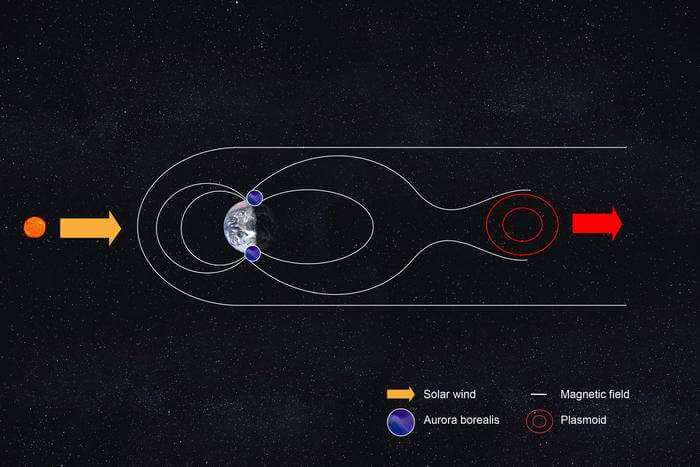How are plasma eruptions in near-Earth space formed? Vlasiator, a model designed at the University of Helsinki for simulating near-Earth space, demonstrated that the two central theories on the occurrence of eruptions are simultaneously valid: eruptions are explained by both magnetic reconnection and kinetic instabilities.
Rapid plasma eruptions known as plasmoids take place on the nightside of the magnetosphere. Plasmoids are also associated with the sudden brightening of the aurora. The space physics research group at the University of Helsinki investigates and simulates these difficult-to-predict eruptions in near-Earth space using the Vlasiator model.
“The phenomena associated with plasmoids cause the most intense but the least predictable magnetic disturbances, which can cause, for example, disturbances in electrical grids,” says Professor of Computational Space Physics Minna Palmroth from the University of Helsinki.
“These eruptions occur on a daily basis, in varying sizes, in the ‘tail’ of the magnetosphere.”
Palmroth, who was recently awarded the Copernicus Medal, is also the director of the Centre of Excellence in Research of Sustainable Space, and the principal investigator for the Vlasiator simulation.
“The chain of events leading to plasmoids is one of the longest-standing unresolved questions in space physics: solutions have been sought for it since the 1960s,” Palmroth says.
Near-Earth space is a unique place for understanding plasma eruptions
Two competing lines of thinking have been proposed to explain the course of events, the first asserting that magnetic reconnection severs a part of the magnetotail into a plasmoid. According to the other explanation, kinetic instabilities disrupt the current sheet (a wide, thin distribution of electric current) maintaining the tail, which eventually results in the ejection of a plasmoid. Arguments about the primacy of these two phenomena have been ongoing for decades.
“It now appears that the causalities are in fact more complex than previously understood,” Palmroth says.
The Vlasiator simulation, which requires the processing power of a supercomputer, modelled near-Earth space for the first time in six dimensions and on a scale corresponding to the size of the magnetosphere. The 6D modelling was successful in describing the physics phenomena underlying both paradigms.
“It was a difficult technical challenge that no one else has been able to model,” Palmroth says. Behind the achievement is more than 10 years of software development.
Consequently, the study was able to demonstrate that both magnetic reconnection and kinetic instabilities explain the functioning of the magnetotail. The phenomena associated with these seemingly contradictory theories actually both take place, and simultaneously.
The finding helps to understand how plasma eruptions can occur. This helps in designing spacecraft and equipment, observing these events for further research, and improving the predictability of space weather by improving the understanding of near-Earth space.
The findings were published in the distinguished Nature Geoscience journal.

